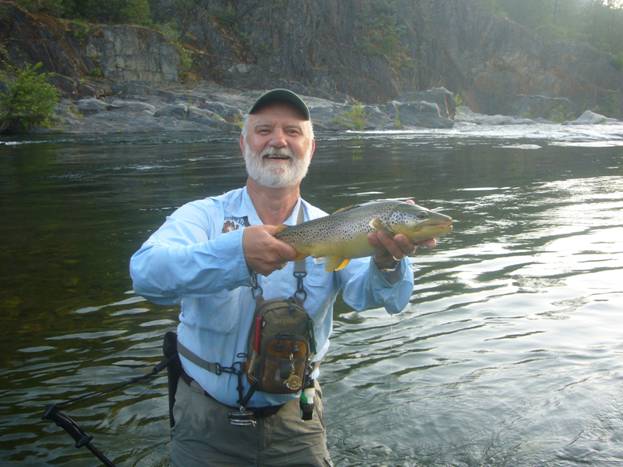First I need to set up my rods.
I tend to carry two rods when fishing. It’s not that difficult and allows you to change from nymphing to dry instantly. I have carried three on rare occasions but it is a bit of a chore. It depends when I am fishing. I don’t carry three rods if I am hiking downstream. Of course having the third rod ready in your car is a good alternative.
DRY FLY:
My old standby Sage XP with a Sharkskin line is my “go to” dry fly rod. The sharkskin line adds about 10’ to 15’ in distance and floats like an indicator. I almost always use two dry flies. I like the large 10 -12 tarantula and stimulators this time of the year as my top fly. Terrestrials also work well. The second fly which is difficult for me to see ( 18” to 24” off the back of the first Fly) is usually a 16-18 BWO, PMD, Parachute Adams and sometimes a small caddis. I like to shake a branch of a nearby tree to see what’s around.
NYMPHING:
For nymphing I use my Sage Switch Rod 11’ 5wt. Last year I used the Rio steelhead 8wt line. You could roll cast a small anchor with this line. You can also send out a mend 30+ feet without much effort. I have sent out mends 50+ feet. I get incredibly long drifts with this setup. I tend to rig this rod for deep water. Nine to twelve foot 3X fluorocarbon leader, 3’ to 4’ of 4X fluorocarbon Tippet. I love the Thingamabobber indicators because they are easy to see, have little air resistance and the can hold up that small anchor if you use the large size. I like the large centipede and other rubber legged nymphs as the top fly. 18” off the back of this fly I like, 16-18 PT’s, Micro May, Prince Nymphs, Copper Johns, Bird of Prey and a whole assortment of small nymphs. Turn over a rock and see what the fish are eating. I have been wanting to pick up a net to catch what floats out after turning over the rock. Lastly the weight. If it’s deep 3 BB’s are my go to weight. I have two methods of putting on the weight. The first is just above the knot between the leader & tippet. This keeps it from sliding down to the fly. The second is to tie about 6” to 12” of 5X or 6X tippet off the bottom fly with a knot at the end. I add the BB’s above the knot. This way gets the line down fast and also helps avoid getting snagged on the bottom. If the BBs get stuck it’s easy to break them off and add more. I do not have a clear preference in which to use.
SINKING LINES:
My third rod is either my 6wt Sage Z Axis or the 5wt I built with Larry Lee a friend and local rod builder. I like the Teeny 200 up to about 15’ deep in slow to moderate flows. Below that I use the Deep 7 to get down quickly and in fast water. I use Sculpins, Wooly Buggers and Streamers. This year I am going to use much larger streams for two reasons. The first is that we have had members catch 12+” rainbows that were attacked by huge browns. The second is that monster brown I sent recently was caught on a fly that was described as “needing a hard hat” to fish safely.
If any of you would like to share your methods or tips please send them to me and I will publish them under your name.
I hope this helps your fishing.
Tom




Leave A Comment
You must be logged in to post a comment.